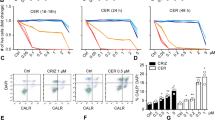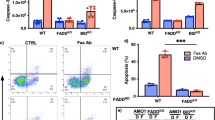Abstract
Rituximab (chimeric anti-CD20 monoclonal antibody) is the first Food and Drug Administration approved antitumor antibody and is used in the treatment of B-non-Hodgkin's lymphoma (B-NHL). It is used as single monotherapy or in combination with chemotherapy and has improved the treatment outcome of patients with B-NHL. The in vivo mechanisms of rituximab-mediated antitumor effects include antibody-dependent cellular cytotoxicity (ADCC), complement-dependent cell cytotoxicity (CDC), growth-inhibition and apoptosis. A subset of patients does not initially respond to rituximab and several responsive patients develop resistance to further rituximab treatment. The mechanism of rituximab unresponsiveness is not known. Besides the above-postulated mechanisms, rituximab has been shown to trigger the cells via CD-20. Studies performed with B-NHL cell lines as model systems revealed several novel mechanisms of rituximab-mediated effects that are involved in chemo/immunosensitization and the development of resistance to rituximab. Rituximab has been shown to inhibit the p38 mitogen-activated protein kinase, nuclear factor-κB (NF-κB), extracellular signal-regulated kinase 1/2 (ERK 1/2) and AKT antiapoptotic survival pathways, all of which result in upregulation of phosphatase and tensin homolog deleted on chromosome ten and Raf kinase inhibitor protein and in the downregulation of antiapoptotic gene products (particularly Bcl-2, Bcl-xL and Mcl-1), and resulting in chemo/immunosensitization. Further, rituximab treatment inhibits the overexpressed transcription repressor Yin Yang 1 (YY1), which negatively regulates Fas and DR5 expression and its inhibition leads to sensitization to Fas ligand and tumor necrosis factor-related apoptosis-inducing ligand-induced apoptosis. Rituximab-resistant clones were generated as model to examine the mechanism of in vivo rituximab unresponsiveness. These clones showed reduced expression of CD20 and hyperactivation of the above antiapoptotic signaling pathways and failure of rituximab to trigger the cells leading to inhibition of ADCC, CDC and chemo/immunosensitization. Interference with the hyperactivated pathways with various pharmacological and proteasome inhibitors reversed resistance. Furthermore, the above findings have identified several gene products that can serve as new prognostic/diagnostic biomarkers as well as targets for therapeutic intervention in B-NHL.
This is a preview of subscription content, access via your institution
Access options
Subscribe to this journal
Receive 50 print issues and online access
$259.00 per year
only $5.18 per issue
Buy this article
- Purchase on Springer Link
- Instant access to full article PDF
Prices may be subject to local taxes which are calculated during checkout


Similar content being viewed by others
References
Alas S, Bonavida B . (2001). Rituximab inactivates signal transducer and activation of transcription 3 (STAT3) activity in B-non-Hodgkin's lymphoma through inhibition of the interleukin 10 autocrine/paracrine loop and results in down-regulation of Bcl-2 and sensitization to cytotoxic drugs. Cancer Res 61: 5137–5144.
Alas S, Bonavida B . (2003). Inhibition of constitutive STAT3 activity sensitizes resistant non-Hodgkin's lymphoma and multiple myeloma to chemotherapeutic drug-mediated apoptosis. Clin Cancer Res 9: 316–326.
Alas S, Emmanouilides C, Bonavida B . (2001). Inhibition of interleukin 10 by rituximab results in down-regulation of bcl-2 and sensitization of B-cell non-Hodgkin's lymphoma to apoptosis. Clinc Cancer Res 7: 709–723.
Baritaki S, Huerta-Yepez S, Sakai T, Spandidos S, Bonvida B . (2007). Mol Cancer Ther (in press).
Bezombes C, Grazide S, Garret C, Fabre C, Quillet-Mary A, Muller S et al. (2004). Rituximab antiproliferative effect in B-lymphoma cells is associated with acid-sphingomyelinase activation in raft microdomains. Blood 104: 1166–1173.
Blay JY, Burdin N, Roousset F, Lenoir G, Biron P, Philip T et al. (1993). Serum interleukin-10 in non-Hodgkin's lymphoma: a prognostic factor. Eur J Immunol 23: 768–771.
Coiffier B . (2005). First-line treatment of follicular lymphoma in the era of monoclonal antibodies. Clin Adv Hematol Oncol 3: 484–491 505.
Cragg MS, Walshe CA, Ivanov AO, Glennie MJ . (2005). The biology of CD20 and its potential as a target for mAb therapy. Curr Dir Autoimmun 8: 140–174.
Deans JP, Kalt L, OLednetter JA, Schieven GL, Bolen JB, Johnson P . (1995). Association of 75/80-kDa phosphoproteins and the tyrosine kinases Lyn, Fyn, and Lck with the B cell molecule CD20. Evidence against involvement of the cytoplasmic regions of CD20. J Biol Chem 270: 22632–22638.
Deans JP, Li H, Polyak MJ . (2002). CD20-mediated apoptosis: signalling through lipid rafts. Immunology 107: 176–182.
Deans JP, Robbins SM, Polyak MJ, Savage JA . (1998). Rapid redistribution of CD20 to a low density detergent-insoluble membrane compartment. J Biol Chem 273: 344–348.
Deans JP, Schieven GL, Shu GL, Valentine MA, Gililand LA, Aruggo A et al. (1993). Association of tyrosine and serine kinases with the B cell surface antigen CD20. Induction via CD20 of tyrosine phosphorylation and activation of phospholipase C-gamma 1 and PLC phospholipase C-gamma 2. J Immunol 151: 4494–4504.
Demiden A, Lam T, Alas S, Hariharan K, Hanna N, Bonavida B . (1997). Chimeric Anti-CD20 (IDEC-c2B8) monoclonal antibody sensitizes a B-cell lymphoma cell line to cell killing by cytotoxic drugs. Cancer Biother Radiopharm 12: 177–186.
Dixit V, Mak TW . (2002). NF-kappaB signaling. Many roads may lead to Madrid. Cell 111: 615–619.
Freedman A, Nadler L . (1991). Immunologic markers in non-Hodgkin's lymphoma. Hematol Oncol Clinics North Am 5: 871–889.
Fisher RI, Gaynor ER, Dahlberg S, Oken MM, Grogan TM, Mize EM et al. (1993). A phase III comparison of CHOP vs. m-BACOD vs. ProMACE-CytaBOM vs. MACOP-B in patients with intermediate- or high-grade non-Hodgkin's lymphoma: results of SWOG-8516 (Intergroup 0067), the National High-Priority Lymphoma Study. N Engl J Med 328: 1002–1006.
Garban HJ, Bonavida B . (2001). Nitric oxide inhibits the transcription repressor Yin-Yang 1 binding activity at the silencer region of the Fas promoter: a pivotal role for nitric oxide in the up-regulation of Fas gene expression in human tumor cells. J Immunol 167: 75–81.
Ghosh S, Karin M . (2002). Missing pieces in the NF-kappaB puzzle. Cell 109: S81–S96.
Golay J, Zaffaroni L, Vaccario T, Lazzari M, Borleri GM, Bernasconi S et al. (2001). Biologic response of B lymphoma cells to anti-CD20 monoclonal antibody rituximab in vitro: CD55 and CD59 regulate complement-mediated cell lysis. Blood 98: 3383–3389.
Haidar JH, Shamseddine A, Salem Z, Mrad YA, Nasr MR, Zaatari G et al. (2003). Loss of CD20 expression in relapsed lymphomas after rituximab therapy. Eur J Haematol 70: 330–332.
Hainsworth JD . (2004). Prolonging remission with rituximab maintenance therapy. Semin Oncol 31: 17–21.
Huerta-Yepez S, Vega MI, Jazirehi AR, Garban H, Hongo F, Cheng G et al. (2004). Nitric oxide sensitizes prostate carcinoma cell lines to TRAIL-mediated apoptosis via inactivation of NF-kappa B and inhibition of Bcl-xl expression. Oncogene 23: 4993–5003.
Janas E, Priest R, Wilde JI, Malhotra R . (2005). Rituxan (anti-CD20 antibody)-induced translocation of CD20 into lipid rafts is crucial for calcium influx and apoptosis. Clinc Exp Immunol 139: 439–446.
Jazirehi AR, Bezombes C, Laurant G, Libra M, Bonavida B . (2006). Characteristics of rituximab-resistant B-NHL clones: deficiencies in rituximab-mediated changes in lipid raft microdomains and cell signaling. Proc Am Assoc Cancer Res 47: (Abstract 4657).
Jazirehi AR, Bonavida B . (2005). Cellular and molecular signal transduction pathways modulated by rituximab (rituxan, anti-CD20 mAb) in non-Hodgkin's lymphoma: implications in chemosensitization and therapeutic intervention. Oncogene 24: 2121–2143.
Jazirehi AR, Gan XH, de Vos D, Emmanouilides C, Bonavida B . (2003). Rituximab (anti-CD20) selectively modifies Bcl-xL and apoptosis protease activating factor-1 (Apaf-1) expression and sensitizes human non-Hodgkin's lymphoma B cell lines to paclitaxel-induced apoptosis. Mol Cancer Ther 2: 1183–1193.
Jazirehi AR, Vega MI, Chatterjee D, Goodglick L, Bonavida B . (2004a). Inhibition of the Raf-MEK1/2-ERK1/2 signaling pathway, Bcl-xL down-regulation, and chemosensitization of non-Hodgkin's lymphoma B cells by Rituximab. Cancer Res 64: 7117–7126.
Jazirehi AR, Huerta-Yepez S, Cheng G, Bonavida B . (2005). Rituximab (chimeric anti-CD20 monoclonal antibody) inhibits the constitutive nuclear factor-{kappa}B signaling pathway in non-Hodgkin's lymphoma B-cell lines: role in sensitization to chemotherapeutic drug-induced apoptosis. Cancer Res 65: 264–276.
Jazirehi AR, Umezawa K, Bonavida B . (2004b). Sensitization of rituximab-resistant Ramos RR1 and Daudi RR1 clones to various chemotherapeutic drugs by a novel nuclear factor-κB activation inhibitor. Blood 104: 3410 (Abstract).
Jazirehi AR, Vega MI, Bonavida B . (2007). Development of rituximab-resistant lymphoma clones with altered cell signaling and cross resistance to chemotherapy. Cancer Research 67: 1270–1281.
Kennedy AD, Beum PV, Solga MD, DiLillo DJ, Lindorfer MA, Hess CE et al. (2004). Rituximab infusion promotes rapid complement depletion and acute CD20 loss in chronic lymphocytic leukemia. J Immunol 172: 3280–3288.
Kennedy AD, Solga MD, Shcuman TA, Chi AW, Lindorfer MA, Sutherland Wm et al. (2003). An anti-C3b(i) mAb enhances complement activation, C3b(i) deposition, and killing of CD20+ cells by rituximab. Blood 101: 1071–1079.
Manshouri T, Do KA, Wang X, Giles FJ, O'Brien SM, Saffer H et al. (2003). Circulating CD20 is detectable in the plasma of patients with chronic lymphocytic leukemia and is of prognostic significance. Leuk Lymphoma 44: S15–S27.
Reff ME, Carner K, Chambers KS, Chinn PC, Leonar JE, Raab R et al. (1994). Depletion of B cells in vivo by a chimeric mouse human monoclonal antibody to CD20. Blood 83: 435–445.
Semac I, Palomba C, Kulangara K, Klages N, van Echten-Deckert G, Borisch B et al. (2003). Anti-CD20 therapeutic antibody rituximab modifies the functional organization of rafts/microdomains of B lymphoma cells. Cancer Res 63: 534–540.
Shan D, Ledbetter JA, Press OW . (2000). Signaling events involved in anti-CD20-induced apoptosis of malignant human B cells. Cancer Immunol Immunother 48: 673–683.
Suzuki E, Bonavida B . (2007). Rituximab inhibits the constitutively activated PI3K-Akt pathway in B-NHL cell lines: involvement in chemosensitization to drug-induced apoptosis. Oncogene (in press).
Vega MI, Huerta-Yepez S, Garban H, Jazirehi AR, Emmanouilides C, Bonavida B . (2004). Rituximab inhibits p38 MAPK activity in 2F7 B NHL and decreases IL-10 transcription: pivotal role of p38 MAPK in drug resistance. Oncogene 23: 3530–3540.
Vega MI, Huerta-Yepez S, Jazirehi AR, Garban H, Bonavida B . (2005b). Rituximab (chimeric anti-CD20) sensitizes B-NHL cell lines to Fas-induced apoptosis. Oncogene 55: 8114–8127.
Vega MI, Jazirehi AR, Huerta-Yepez S, Bonavida B . (2005a). Rituximab-induced inhibition of YY1 and Bcl-xL expression in Ramos non-Hodgkin's lymphoma cell line via inhibition of NF-kappa B activity: role of YY1 and Bcl-xL in Fas resistance and chemoresistance, respectively. J Immunol 175: 2174–2183.
Vivanco I, Sawyers CL . (2002). The phosphatidylinositol 3-Kinase AKT pathway in human cancer. Nat Rev Cancer 2: 489–501.
Xerri L, Parc P, Brousset P, Schlaifer D, Hassoun J, Reed JC et al. (1996). Predominant expression of the long isoform of Bcl-x (Bcl-xL) in human lymphomas. Br J Haematol 92: 900–906.
Yeung K, Janosch P, McFerran B, Rose DW, Mischak H, Sedivy JM et al. (2000). Mechanism of suppression of the Raf/MEK/extracellular signal-regulated kinase pathway by the raf kinase inhibitor protein. Mol Cell Biol 20: 3079–3085.
Yeung KC, Rose DW, Dhillon AS, Yaros D, Gustafsson M, Chatterjee D et al. (2001). Raf kinase inhibitor protein interacts with NF-kappaB-inducing kinase and TAK1 and inhibits NF-kappaB activation. Mol Cell Biol 21: 7207–7217.
Yeung K, Seitz T, Li S, Janosch P, McFerran B, Kaiser C et al. (1999). Suppression of Raf-1 kinase activity and MAP kinase signalling by RKIP. Nature 410: 173–177.
Acknowledgements
We acknowledge the following investigators for their valuable contributions: Steve Alas, PhD; Ali R Jazirehi, PhD; Mario Vega, PhD; Sara Huerta-Yepez, PhD; Stavroula Baritaki, PhD; Kam Yeung, PhD; Eriko Suzuki; Kazuo Umezawa, PhD; James Berenson, MD; Massimo Libra, MD, PhD. The author also acknowledges the assistance of Maggie Yang in the preparation of the manuscript. The study was supported in part by a contribution from the Ann C Rosenfield under the direction of David Leveton, the Jonnson Comprehensive Cancer Center and the Fogarty International Center Fellowship and UC-Nexus Conacyt.
Author information
Authors and Affiliations
Corresponding author
Rights and permissions
About this article
Cite this article
Bonavida, B. ‘Rituximab-induced inhibition of antiapoptotic cell survival pathways: implications in chemo/immunoresistance, rituximab unresponsiveness, prognostic and novel therapeutic interventions’. Oncogene 26, 3629–3636 (2007). https://doi.org/10.1038/sj.onc.1210365
Published:
Issue Date:
DOI: https://doi.org/10.1038/sj.onc.1210365



